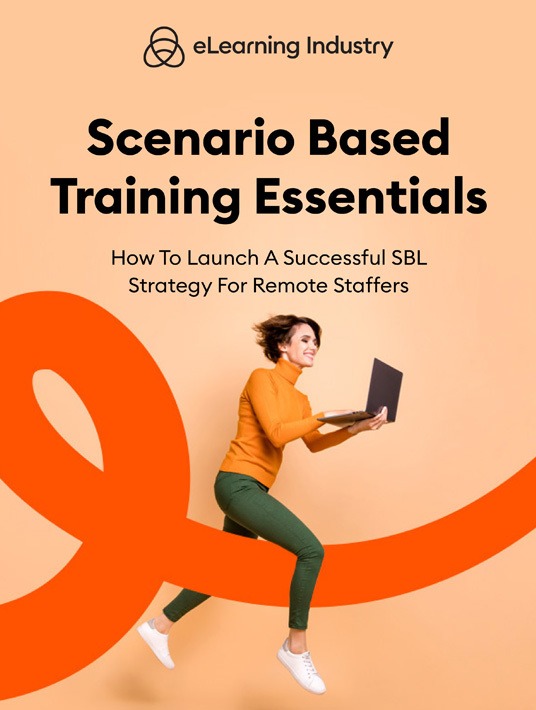How To Develop Engaging Scenario-Based Training For Telecommuting Teams
Real-world application is the #1 goal of online training. You can’t boost company profits and customer satisfaction scores if employees don’t know how to use all their skills and industry know-how. But how do you put all those theories, policies, and protocols into practice for your remote workforce? Scenario-based training is framed by real-world problems, tasks, and situations. Employees can identify negative performance behaviors and build their self-confidence in a supportive online L&D setting. But which elements should you include? How do you find the right outsourcing partner? Which software is best for your bottom line? This article has answers to all your pressing scenario-based learning questions and more.
What's Inside This Guide...
- Quintessential Traits Of Successful Scenario-Based Learning Experiences
- Scenario-Based Training Budgeting Tips And Tricks To Avoid Overspending
- Stress-Free Ways To Find The Right Scenario-Based Training Solutions Provider
- Ways To Use Scenario-Based Training Solutions Ratings And Reviews
- Tips To Find The Right Branching Scenario Software For Your SMB

1. Quintessential Traits Of Successful Scenario-Based Learning Experiences
What should you include in your scenario training activities? Ultimately, SBL is all about building experience and facilitating mistake-driven learning opportunities. Thus, every resource needs to be relatable, relevant, and real-world-centered. Here are 9 quintessential traits of successful scenario-based learning experiences that your L&D staffers must consider.
1. Framed By Clear Objectives
As is the case for all successful training activities, the foundation is clear objectives and goals that tie into performance behaviors. Develop concise objective statements for the skills, competencies, and gaps you must address in scenario-based learning experiences, which you can use to design meaningful storylines and characters that personalize the process and build contextual knowledge. For example, this branching scenario reinforces COI compliance know-how and practical application. Employees must be able to determine if the client’s offer is a bribe or merely a negotiation tactic.
2. Filled With Practical Challenges
The crux of learner engagement in scenario training is relatability. Every challenge must be rooted in facts, such as situations and problems that employees face on a daily basis. This is not the time for far-flung plots just for the sake of entertainment. Frame each scenario-based learning experience with a realistic obstacle that calls for workplace skills, resources, and firsthand expertise. That aid, the challenges shouldn’t be overwhelming for your busy staffers. Keep activities bite-sized and include pop-out pointers for those who need some extra guidance.
3. Includes Decision-Making Paths
Scenario-based learning activities typically feature branching paths with corresponding decision points. Every choice brings trainees down a different path, in hopes of achieving the most favorable outcome. However, there are other destinations on that branching scenario spectrum. For instance, the employee may possess all the necessary competencies, but they lack experiential knowledge. The outcome reflects this missing piece of the puzzle so that employees can fill gaps autonomously without overlooking their strong suits.
4. Contains Outcomes That Mimic Real-World Repercussions
The outcomes aren’t merely there to highlight personal pain points. They must also emphasize real-world repercussions, both good and bad. For example, mishandling a customer service issue leads to unhappy consumers and loss of business. While applying all the right skills and product knowledge increases repeat business. There is a caveat, however. Outcomes must reinforce positive performance behaviors and create an emotional connection without causing undue stress. Employees shouldn’t walk away from the training activity feeling defeated.
5. Highlights True-To-Life Characters And Tasks
Successful scenario training is based in realism. Incorporate true-to-life characters, storylines, and tasks to enhance immersion and learner engagement. Employees need to feel like they’re part of the action. That their choices carry weight and a direct impact on the end result. They should also be able to recognize personas they see in the workplace. Free of exaggerated traits that distract them from the training objectives. Dialogue and decision points should also be realistic to draw them into the scenario-based learning experience.
6. Incorporates Self-Reflection Prompts
I’m not suggesting that you pause in the middle of a branching scenario screen to make employees second-guess their choices. Self-reflection prompts are more discreet. They should encourage staffers to evaluate habits, cognitions, and task performance to identify personal gaps. To analyze their current strategy and problem-solving tactics in a supportive setting, instead of making them doubt every decision they make. Another approach is to ask questions that trigger self-evaluation.
7. Offers Immediate Feedback
One of the key differentiating factors between games and training scenarios is built-in feedback. Branching scenarios actually incorporate two forms of feedback. The first is subtler. Employees achieve unfavorable outcomes, which prompts them to rethink their decisions and performance behaviors. The second is direct feedback. This comes in the form of follow-up recommendations and checklists. For example, these are the areas where they excelled and these are the skills they must develop to improve proficiency.
8. Provides Mistake-Driven Learning Opportunities
First and foremost, scenario-based learning is all about making mistakes and learning from them; venturing down the wrong path and seeing where it leads. Encourage employees to take risks to explore different outcomes so that they don’t have to take those risks in the workplace. This is where feedback becomes crucial. Trainees must know where they went wrong and how to approach the problem differently moving forward.
9. Always Accompanied By Supplemental Support
Every scenario training exercise must end with a recap of employee performance and next steps. They’ve made their way through the decision paths to the finish line, but how can they address newly disclosed gaps? Summarize their strengths and areas for improvement, as well as supplemental support tools they can access in the LMS repository. You can also launch social media groups or peer coaching programs to provide personalized support. For example, they can check out the discussion board to ask questions, gather peer feedback, and access the pinned resource list.
2. Scenario-Based Training Budgeting Tips And Tricks To Avoid Overspending
Developing a realistic budget is relatively easy once you reevaluate your training needs and take stock of existing assets. Sticking to it is an entirely different story. Costs can pile up quickly and those pesky hidden fees cause unnecessary implementation delays. Whether you’re creating your own content or hiring a scenario-based learning company, overspending is a risk. There’s always the possibility that software learning curves and unforeseen design obstacles will add to the L&D tally. However, there are some trade secrets to help you work within the confines of your scenario training budget and maximize resource allocation.
1. Conduct A Training Needs Analysis
Spending can spiral out of control if you don’t identify the project scope. Conduct a TNA to evaluate your current and future needs. LMS metrics, employee surveys, and assessments are just a few of the ways to diagnose pain points. You can also evaluate your library to disclose underperforming resources and determine why they’re collecting virtual dust. A training needs analysis is crucial because it allows you to draft an effective RFP (request for proposal) when it’s time for vendor bids. Another perk is avoiding redundancies. You don’t request deliverables for objectives or outcomes that are already addressed in your course catalog.
2. Identify Reusable Assets
One of the most effective cost-cutters is repurposed content. Assets you can reuse for scenario training to stretch your budget and reduce the development timeline. Take stock of your library and archives to look for images, video clips, and other multimedia you can incorporate into the new design or even hand over to the outsourcing company so that they can work their magic and reuse those outdated materials. Some vendors even request free reign of your resource repository so they can pick and choose relevant resources.
3. Do Market Research To Set A Spending Cap
Do online research to determine the "going rate" for scenario-based learning content. How much do vendors typically charge for their services? What are the software costs involved? Are there online guides or social media posts that break down the expenses by deliverable or task? Of course, every project is different. However, some basic market research can help you set a more realistic spending cap based on current price tags. Bear in mind that expenses fluctuate throughout the years. A project that may have cost XX amount ten years ago may be significantly higher today. You can also request a quote directly from vendors to get a rough estimate before you create your outsourcing budget.
4. Differentiate In-House From Outsourced Tasks
You must have a clear idea of how outsourcing fits into your picture. Which tasks will you handle internally? Which deliverables will you add to the outsourcing list? Develop two distinct budgets that include everything from human resources to learning management systems. Then, combine the two to formulate a more holistic scenario-based training budget. This also makes it easier to adjust costs in both columns and reevaluate your outsourcing strategy. For example, you realize that it’s more expensive to develop the customer service scenario training course in-house, due to software costs and payroll. Thus, it’s more prudent to move that task to the outsourcing side before you submit the RFPs.
5. Outsource In Stages
There’s no rule that says you have to outsource the entire project in one go. Why not break it into stages with feedback breaks in between? For instance, the first round involves this set of deliverables for the sales department. After you receive the content from the provider, you can meet with your team to discuss the results. Are you satisfied with the outcome and overall CX? Is there room in your budget to proceed to the next phase or should you wait until you free up more funds? This also gives you time to evaluate how the content performs in the real world. Analyze LMS metrics and business reports to see if the outsourced resources live up to your expectations. Keep in mind that every stage requires a different contract. Or you can opt for a flexible agreement that requires your approval before moving to the next round of deliverables.
6. Evaluate Vendor Ratings And Reviews
User reviews and ratings aren’t just for gauging the quality of work or responsiveness. They can also help you set a more accurate budget and prevent overspending thanks to an insider’s perspective. Do any of the users mention cost concerns? For instance, the project ended up costing them far more than expected, or the vendor wasn’t able to reuse their existing assets. The value for money rating is also helpful to determine which vendor delivers the best ROI.
7. Get Everything In Writing
Ensure that all the costs are outlined in your outsourcing contract and the payment terms. For example, how often does the vendor expect milestone payments and what’s their preferred invoicing method? A carefully crafted agreement can prevent budget overages because there are no unwanted surprises, like additional content curation or authoring tool costs. The vendor must include everything in the final estimate so that you can plan accordingly.
3. Stress-Free Ways To Find The Right Scenario-Based Training Solutions Provider
Misconceptions often become an outsourcing roadblock. Maybe you’ve heard that hiring a third-party content provider is pricey or that you’re excluded from the revision process or that your team must take a backseat when it comes to creative input. However, choosing the right outsourcing company for your project makes a world of difference. A content provider should break down the communication barriers and take your feedback into consideration. They should also respect your budget and implementation timeline to maximize ROI. But where can you find an eLearning scenario design company that delivers the total package? Here are 8 headache-free ways to select the perfect scenario-based training partner at the perfect price point.
1. Online Directories
Whether you’ve already worked with a scenario-based training company or are new to the outsourcing scene, online directories are a valuable resource. They feature company bios, solutions, and key selling points to help you narrow the shortlist rapidly. It’s stress-free because all the info is gathered in one place. You can even filter results to speed up the search and identify vendors who meet all your criteria, such as customer type and specialization area.
2. Review Sites
Unlike eLearning software that typically features test drives and demos, there’s no feasible way to evaluate vendors firsthand. Short of hiring them all for sample projects (which I address later in this post). Thus, you need to rely on user experiences with the content provider. What they liked best and least about the project and if they’re likely to recommend them. Review sites give you a behind-the-scenes glimpse of the company’s quality of work, customer service, and adherence to deadlines.
3. Vendor Ratings
Ratings are another free vendor vetting resource at your disposal. The secret is to find a site that features unbiased and unsponsored scores. They should also be backed by valid evaluation criteria. For example, the user must evaluate various aspects of the project and this data is used for the overall satisfaction rating. Another insider tip is to sort listings by rating so that the cream of the outsourcing crop rises to the top.
4. Top Companies Lists
Every organization has unique scenario-based learning requirements and goals. However, there are certain qualifications that every outsourcing company should have to warrant the investment. Top vendor lists highlight the best partners for your project based on strict evaluation criteria. These companies have made a name for themselves through their commitment to quality and customer support. They know how to use the latest branching scenario software to create meaningful, results-driven content.
5. In-House Suggestions
Ask staff members for recommendations regarding vendors they’ve worked with in the past. Maybe they collaborated with a scenario-based training provider before they joined your team, or they’ve heard great things about an eLearning scenario design company from a friend. Open the floor to suggestions and give staffers some basic project info so they know what you’re looking for. As an example, this is the list of deliverables, objectives, and general budget.
6. Social Media Recommendations
Another way to solicit recommendations in bulk is to put out "feelers" on social media. Preferably, closed groups that specialize in online training or L&D. Ask members for suggestions after giving them some basic project details, such as how much you’re willing to allocate to the deliverables and the general training topics. Some social media pages even have pinned recommendation lists where you can find outsourcing partners. You can also visit the vendor’s profile directly to read what others have to say about their service. For instance, there are numerous comments on their posts from satisfied clients.
7. Sample Projects
It’s not free, but it is one of the most thorough ways to verify vendor qualifications and customer service. Hire them for a test project. Possibly a microlearning scenario for your sales team that doesn’t require a sizable investment. This allows you to evaluate everything from contract terms and communication to the quality of the finished product. If all goes well, you can hire them for more involved eLearning scenario design deliverables with a higher price tag. Another thing to consider during the sample project is the revision process. Do they ask for your input and incorporate your suggestions into the final design? How well does your team mesh with theirs? Are they able to repurpose some of your assets to reduce spending?
8. Evaluate Support Services
There are multiple ways to evaluate the scenario-based training company’s support services. The first is ratings that center on responsiveness and CX, as well as reviews that mention the vendor’s level of support throughout the outsourcing project. However, you can also test their support offerings firsthand through email and social media groups. Reach out with a fairly basic question to see how long it takes them to respond and how they address the issue. For example, do they respond to your Facebook comment a week later or are there sales reps always standing by?
4. Ways To Use Scenario-Based Training Solutions Ratings And Reviews
Ratings and reviews are not, by any means, the only reference tool in your arsenal. However, they do offer an inside look at service quality, vendor responsiveness, and value for money. Their valuable insights can help your organization compile a list of top contenders with the same L&D priorities and work ethics. But not all reviews carry the same weight. The user’s background, experience level, and training requirements are all factors to consider. Here are 8 cost-effective ways to use scenario training solutions ratings and reviews to find the perfect outsourcing partner, as well as tips to decipher satisfaction scores so that you can evaluate options fairly.
1. Filter Results By Overall Rating
The goal is to find the best scenario-based training solutions quickly without cutting corners. Thus, you should begin by filtering results by overall rating. This automatically brings the top interactive learning activities providers to the top of the page. These are the companies with an established track record and positive reviews. Users have gone to the trouble of rating the service they received because they want you to know about these standout solutions.
2. Weigh The Benefits And Drawbacks
Every review explores what the client liked best and least about their experience with the outsourcing company. Thus, you’re able to evaluate the pros and cons of hiring them for your scenario-based learning program. Of course, every project is different and there’s no guarantee that you’ll get the same level of customer service or quality of work. However, outsourcing partners with numerous satisfied clients are more likely to live up to expectations. Pay close attention to the benefits and drawbacks mentioned in each review to determine if the content provider aligns with your needs.
3. Center On Reviews With A Similar Use Case
Users are required to include some basic info. Including their industry, company size, and training focus. As such, you’re able to concentrate on ratings and reviews with a similar use case and scenario-based learning scope. These reviews offer greater insights. As they give you a better idea of whether the vendor understands your industry’s training requirements and needs. For example, the user also hired them for sales training, and they have under 200 employees. This indicates that the content provider is used to working with SMBs and can help boost your sales stats.
4. Compare Star Ratings Versus Your Top Priorities
The overall ratings are based on six key areas: achieved results, responsiveness, communication, value for money, deadlines, and quality of service. While all of these are essential evaluation criteria, some are higher on your priorities list. For instance, you’re looking for a scenario training firm that maintains active communication because that’s been an issue in the past. Or you need an outsourcing partner that treats every client like a VIP. Thus, the quality of service score is your main concern. You can also read reviews to clarify the scores and determine why the user deducted stars.
5. Assess Reviews In Chronological Order
Missing deadlines or not communicating with clients is a major faux pas. However, everyone’s allowed to make mistakes as long as they learn from them. Reviews from three years ago might reflect some glaring customer service or responsiveness issues. But more current ratings are full of praise. Analyze the reviews in chronological order so that you can see how the content provider has evolved and if they’ve addressed performance issues. This also allows you to focus on recent projects that factor in current technology, skill sets, and work practices.
6. Don’t Stop At The Summary Statement
Many directory visitors quickly scan the page for summary statements but don’t delve into the actual review or ratings. It’s important to evaluate each vendor holistically so that you don’t miss out on a valuable outsourcing opportunity. That said, the summary at the beginning can shed light on the vendor’s strong suits or weaknesses. If multiple reviewers mention the same service issue, this might be a major red flag.
7. Consider The Source
Ratings and review sites should be, above all else, unbiased. You should be able to evaluate every vendor based on their own merit instead of trying to sort sponsored reviews from genuine opinions. Therefore, you must consider the source. Rely on sites that require users to login via social media or provide some basic background info. This reduces the risk of paid reviews and exaggerated or unfair claims.
8. Check Out The Vendor’s Site
Take it a step further by visiting the content provider's site to assess their interactive learning activities portfolio and price point. This also gives you the chance to evaluate their design skills and aesthetics, as well as their list of satisfied clients. For example, it features a brief blurb from companies who’ve worked with the vendor and highly recommend their services. Granted, you’ll probably only find favorable testimonials because the company wants to put their best outsourcing foot forward, which is why the third-party review sites are such a valuable reference tool.
5. Tips To Find The Right Branching Scenario Software For Your SMB
Even if you outsource learning scenario design, it’s always best to have software on hand for future revisions and content upkeep. This also allows you to gradually expand your asset inventory in-house to enrich the training experience. If you take the third-party content provider route, it’s also essential to verify their list of top tools to avoid compatibility issues. For example, their software may not mesh with your existing LMS or require extensive reformatting. The question is: Which branching scenario tools are best for your profit margin AND experience level? You need to find platforms that not only fall into your price range but lower the tech learning curve. So, here are some insider tips to choose the right learning scenario design tool for the task.
1. Prioritize User-Friendly UIs
Front and back-end users should be able to utilize all the features and functions. Your L&D team needs to develop engaging content, and trainees must navigate through branching scenarios with minimal stress. That means no accessibility obstacles or long software learning curves. Usability is one of the key evaluation criteria to consider during your scenario-based learning tool test drive. Ask L&D staffers to develop sample projects, carrying out their usual design flow and work practices. Then, invite a select group of users to analyze the finished product and provide feedback.
2. Look For Customizable Templates
A standout selling point for scenario-based learning software is built-in templates and themes. This allows developers to create interactive content quickly and cost-effectively, even if they have minimal experience. In the case of outsourcing, templates make it easier for your team to update the activity. For example, you can add additional media, decision points, or dialogue to align with new objectives.
3. Evaluate The Character Library
The character library should have a broad range of images to choose from, specifically high-quality images that you can reuse time and again for different branching scenario design projects. It should also feature a diverse cast of characters to reflect your talent pool and customer base, as well as their unique personality traits and expressions (to suit different situations). Lastly, you should be able to upload your own images to the library to make it even more relatable and relevant.
4. Choose Platforms With Brand Integration
Whether you plan to outsource or tackle scenario branching design internally, branding is crucial. The activity must seamlessly integrate into your existing training library and reflect your brand image. For example, it features your logos, color scheme, and messaging. Even fonts and buttons should align with your brand identity. During the free trial or demo, ensure that you can customize all the essential elements, even if you use the built-in templates.
5. Save Time With Pre-Built Decision Paths
Another time-saving feature to look for in learning scenario design software is decision paths. The tool already has pre-built branches you can customize to suit your training topics and desired outcomes. Your scenario framework is already in place and you can start adding steps and corresponding choices right away instead of laying the technical groundwork beforehand.
6. Consider Multimedia Assets To Cut Costs
You always have the option to curate online content or reuse your own assets. However, multimedia repositories are another item to add to your software shopping list to reduce spending. Plus, you don’t have to deal with compatibility issues, since you know that all the content is suitable for your next scenario design. Evaluate the multimedia library to verify it has all the scenario-building basics. Including video clips, slides, graphs, charts, hot spots, and quiz engines. This is also a good time to ensure that your reusable content is supported. Does the software allow you to quickly migrate your resources or do you have to deal with reformatting obstacles?
7. Analyze The Vendor’s Support Offerings
It’s not only the tool’s functionality and features you need to think about. The vendor must also stand behind their product and provide some degree of support, such as online user forums, FAQs, and a knowledge base. Many vendors also offer phone, email, or live chat assistance to help you maximize value for money. Test out the vendor support services during the free trial by submitting trouble tickets or checking out the user community.
8. Determine If Branching Scenario Software Is YOUR Responsibility
Are you responsible for purchasing branching scenario software or does the vendor include that in the package? If you’re outsourcing learning scenario design, speak with the eLearning content provider about their go-to tools. Will the resources mesh with your current LMS? Are they going to host the content for you? Should your organization invest in software for future content revisions and additions? This is also a point to address in the vendor RFP. Clarify tech specs and which tools you already use to avoid compatibility issues so that the eLearning content provider can include any additional tools in the estimate.
Conclusion
Scenario-based learning isn’t the beginning and end of employee training. You must follow up with knowledge refreshers and skill reinforcement to enhance the long-term benefits. You can even pre-assess employees to identify gaps then suggest the best scenario based on their personal areas for improvement. That said, this interactive and engaging training tool deserves a prominent place in your performance management library. Launch an internal marketing strategy so that employees are aware of the real-world perks. And gather their feedback to continually improve scenario design and make them even more immersive. Finally, vet vendors and evaluate ratings in our free online directory. It has the leading eLearning content providers for scenario-based learning. You can also contact companies directly to request quotes and review their online portfolios.
The selection process may involve a broad range of reference tools, but the ultimate goal is to find a long-term training partner. A company you rely on time and again for interactive and engaging content without going over budget. The alternative is hiring a different third-party provider for every project, which is time-consuming and resource-draining. So, do your homework and use all of the aforementioned tools to make the best buying decision. Don’t hesitate to submit RFPs to your top choices or schedule meetings to see what they have to offer. You can also download our eBook, Scenario-Based Training Essentials: How To Launch A Successful SBL Strategy For Remote Staffers, for all the insider info.








